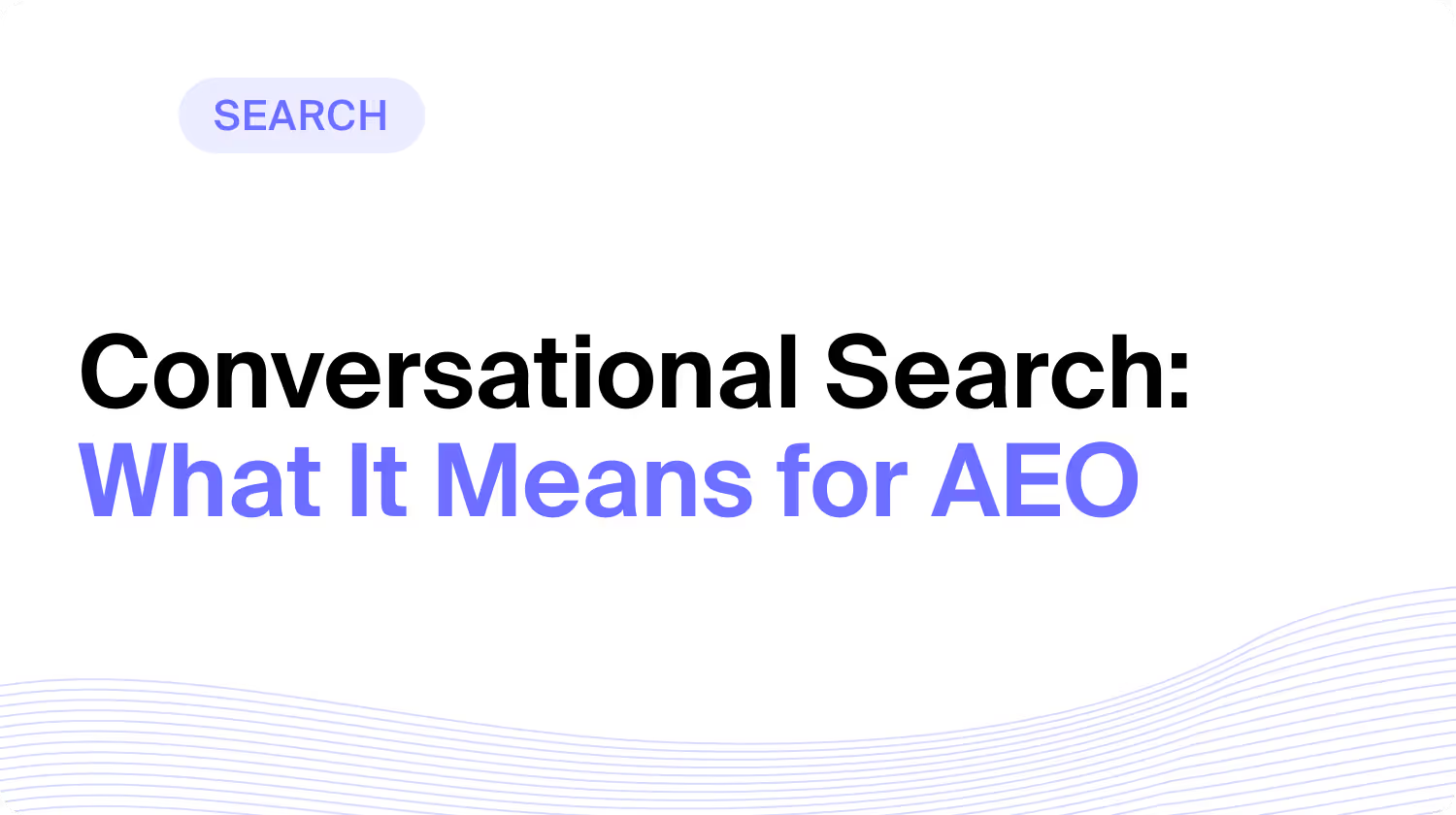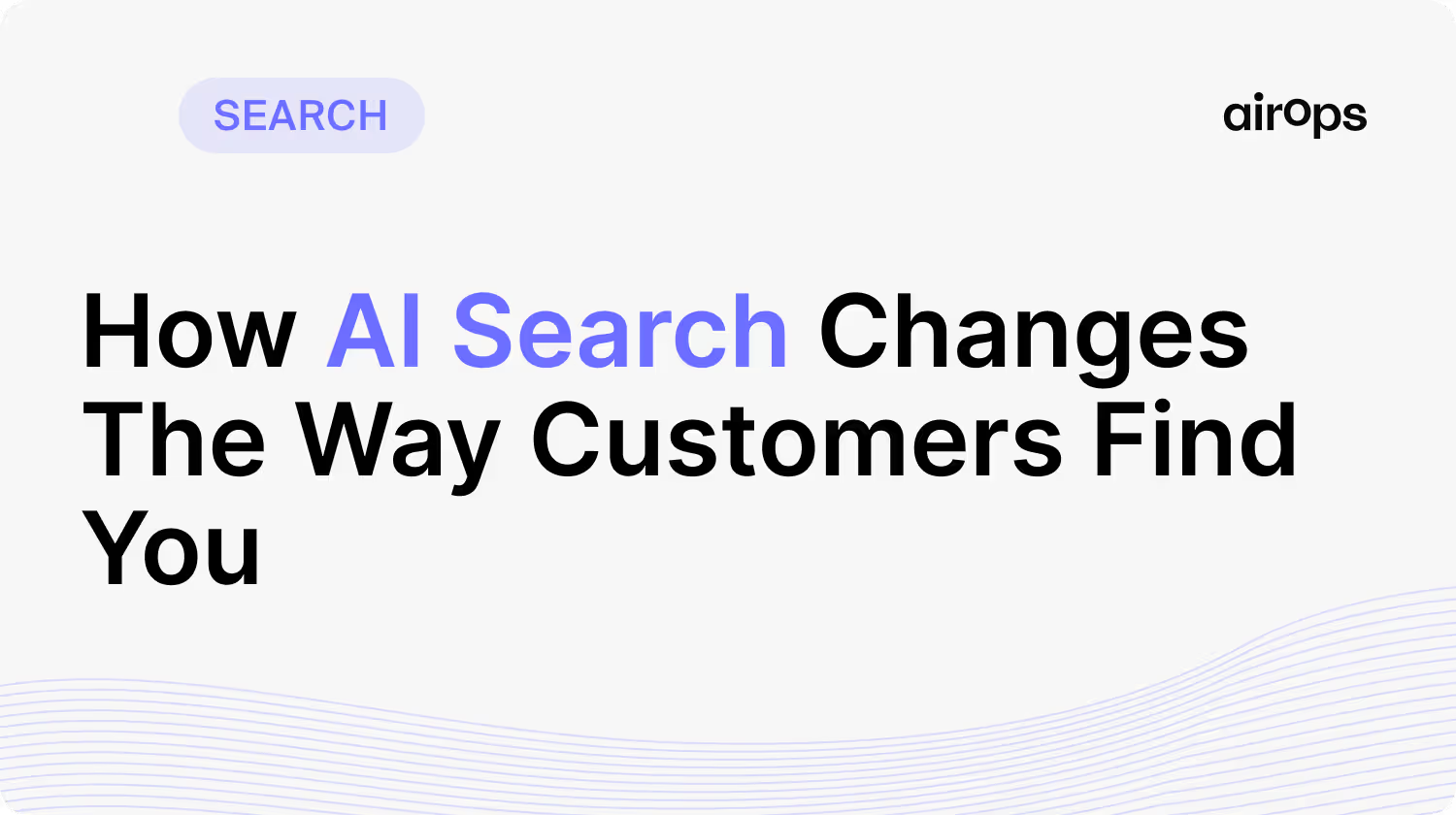Conservational Search: What It Means for AEO

Conversational search enables users to interact with AI systems using natural language, not just keywords.
Conversational search is transforming how people access information across both traditional search engines and answer engines.
In this guide, you’ll learn how conversational search works, why it matters to AEO, and how to effectively optimize your content to improve answer engine visibility.
Conversational search is changing the way people find and interact with information—moving beyond keywords to natural, dialogue-driven exchanges.
Powered by Large Language Models (LLMs) and Natural Language Processing (NLP), conversational search enables users to ask complex, multi-part questions and receive accurate, context-aware answers.
Search results across Google’s AI Overviews, ChatGPT, and Perplexity are leading this shift, reshaping both traditional search behavior and the expectations users bring to digital experiences.
What is Conversational Search?
Conversational search is a search experience that allows users to interact with search engines using natural language, not just keywords. It mimics human dialogue, enabling users to ask full questions, clarify intent, and receive context-aware answers.
Key characteristics of conversational search:
- Understands intent and context beyond exact keywords
- Maintains memory of previous interactions within a session
- Delivers results in a clear, conversational tone
Types of Conversational Search
Conversational search takes different forms depending on the interface, use case, and underlying technology.
Most conversational search interfaces fall into one of the following categories:
1. Chat-Based Interfaces
Chat-based systems use a text-based interface to simulate human conversation. Users ask questions or issue commands, and the AI responds in a conversational tone.
Chat-based examples include:
- ChatGPT, Claude, Perplexity
- Customer support chatbots
- Internal knowledge assistants in Slack or MS Teams
2. Voice-Activated Assistants
Voice-based systems allow users to speak naturally to access information or complete tasks. Voice-activated assistants are common in mobile, smart home, and vehicles.
Examples of voice-activated assistants include:
- Alexa, Siri, Google Assistant
- Voice search on smartphones or smart speakers
- In-car assistants for navigation and support
3. Embedded Interfaces and AI Agents
Conversational search can also be embedded into specific apps, websites, or enterprise tools. This type of conversational search interface often take the form of AI agents that can not only answer questions, but also complete actions, escalate issues, or trigger workflows based on natural language input.
Examples of AI Agents include:
- E-commerce bots that guide shoppers
- Customer support AI Agents
While each type of conversational search varies in complexity––all share the core goal in delivering more natural, efficient, and personalized access to information to users.
Is Voice Search the Same as Conversational Search?
Voice search and conversational search are related but not the same. Voice search refers to the input method—speaking instead of typing—while conversational search refers to how the system processes and responds to queries in a natural, dialogue-like format.
Here are the key differences:
Input Method
- Voice Search: Spoken language
- Conversational Search: Can be spoken or typed
Interaction Style
- Voice Search: Often one-off commands
- Conversational Search: Multi-turn, back and forth dialogue
Context Handling
- Voice Search: Generally limited
- Conversational Search: Maintains memory and intent across inputs & outputs
Technology
- Voice Search: Voice recognition & basic NLP
- Conversational Search: Advanced NLP, LLMs & Context models
How Voice and Conversational Search Work Together:
Modern AI tools like ChatGPT combine both voice input and conversational search capabilities. For example, users can speak a question into the ChatGPT mobile app, and the system will interpret the spoken input, understand the intent, and respond in a natural, conversational format.
This creates a seamless experience where:
- Voice search enables fast, hands-free input
- Conversational AI powers multi-turn, context-aware responses
While many voice assistants still offer limited, command-style responses, ChatGPT and similar LLM models represent the next generation—where spoken input is just the start of a deeper, more intelligent dialogue.
How Does Conversational Search Work?
Conversational search works by using Large Language Models (LLMs) to understand natural language, retrieve semantically relevant information, and generate human-like responses. This enables a more natural, interactive search experience—closely aligned with how people ask questions and seek answers in real life.
This process mirrors how Google’s AI Overviews and modern answer engines return results—by prioritizing user intent over exact keyword matches.
There are three core components to how conversational search works:
1. Understanding the Query (Natural Language Understanding)
The system begins by interpreting the user’s input using Natural Language Processing (NLP) and pre-trained LLMs. These models analyze meaning, context, and structure to determine what the user is asking and why.
To interpret the query, the system uses:
- Intent analysis: Identifies the goal behind the query (e.g., informational, navigational, transactional).
- Entity recognition: Detects named entities such as products, brands, people, dates, or locations.
- Context modeling: Maintains memory of previous interactions or follow-up questions to resolve ambiguity.
- Semantic parsing: Breaks down the query into structured components that map to internal data models.
According to Google, 15% of daily searches are brand new. LLMs outperform traditional systems by understanding meaning rather than relying solely on historical keyword patterns.
2. Retrieving Relevant Information (Semantic Search and Ranking)
Once the query is understood, the system retrieves relevant content from internal databases, APIs, or indexed documents. This step focuses on matching semantic meaning, not just keywords.
To find the most relevant information, the system applies:
- Vector-based semantic retrieval: Maps the user’s query and available documents into embeddings to retrieve meaning-aligned results.
- Relevance ranking: Scores and prioritizes content based on contextual relevance, authority, and freshness.
- Knowledge graph integration: Supplements retrieval with structured entity data and known relationships between concepts.
Semantic search enables more accurate results even when the user’s phrasing doesn’t match the original content—an essential shift for modern SEO and AI-first content strategies that prioritize answer engine optimization.
3. Generating the Response (Natural Language Generation)
After retrieving relevant content, the system constructs a clear, conversational response tailored to the user’s question and history. This is powered by natural language generation (NLG) models like GPT-4.
The response is generated using:
- Context-aware generation: Combines retrieved facts with prior conversation to maintain coherence.
- Tone and format adaptation: Adjusts language for clarity, politeness, or brand voice based on user profile or interaction style.
- Multi-turn dialogue support: Allows for clarifying questions, follow-ups, and refinement without losing context.
- Feedback loops: User behavior (clicks, satisfaction ratings, dwell time) is used to improve future outputs.
According to Gartner, 80% of knowledge workers will use generative AI daily by 2026—highlighting the growing need for conversational systems that deliver accurate, trustworthy, and well-structured responses.
Why Conversational Search Matters for Answer Engine Optimization
Conversational search is fundamentally reshaping how content is discovered, interpreted, and cited by AI-powered platforms—making it an important factor in prioritizing Answer Engine Optimization (AEO).
As users increasingly rely on tools like ChatGPT, Google’s AI Overviews, Perplexity, and Claude to ask questions and get direct answers, the structure and clarity of your content now matter more than ever.
According to Elon University, a 2025 survey found that 52% of U.S. adults now use large language models (LLMs) such as ChatGPT, Gemini, or Claude––demonstrating the mainstream adoption of conversational search tools.
Unlike traditional SEO, which prioritized keyword density and backlinks, AEO focuses on creating content that can be accurately understood and reused by LLMs.
As conversational search becomes the default way users engage with information, optimizing for AEO ensures your content is structured, trusted, and ready to be cited by the LLMs powering modern search experiences.
How to Optimize Content for Conversational Search
To rank in AI Overviews or be cited by tools like ChatGPT or Perplexity, content must be structured for clarity, extractability, and intent alignment—the core signals answer engines rely on.
Conversational search rewards content that directly answers user questions in a format that LLMs can easily interpret, extract, and repurpose.
Here are key strategies to ensure content is AEO optimized for conversational search:
1. Use Clear, Semantic Headings
Structure your content with descriptive H2s and H3s that reflect how users phrase questions.
- Use natural language in headers (e.g., “How does conversational search work?”)
- Match headings to real search queries to improve alignment with user intent
- Break complex topics into smaller, focused sections to improve scannability
2. Answer Questions Directly and Early
Lead with the answer, then provide supporting context.
- Use fact-first formats like “X is…” or “Y refers to…” to improve extractability
- Start each section with a clear topic sentence or definition
Using clear and concise sentences improve extractability for LLMs and make content easier for users to scan and understand.
3. Align Content with User Intent
Conversational search systems understand meaning, not just exact phrases—so your content should reflect real user goals and language patterns.
- Use natural language and semantic variants rather than repeating exact-match keywords
- Structure sections around common question formats (who, what, how, why) to match how users interact with LLMs and AI Overviews.
- Anticipate follow-up questions and address them inline or in related sections
- Include internal links with descriptive anchor text that signals topical relationships
Aligning content with user intent and writing with semantic clarity helps LLMs accurately classify, extract, and cite your content in multi-intent queries.
4. Prioritize Readability and Scannability
LLMs and human readers alike rely on well-structured, easy-to-skim content. Readability and scannability directly impact whether your content gets surfaced, cited, or skipped.
- Break up dense text into short paragraphs (1–3 sentences each)
- Use bullet points, numbered lists, and callouts to highlight key takeaways
- Apply consistent formatting—headings, spacing, font size—to improve visual hierarchy
- Write at an 8th–10th grade reading level to maximize comprehension across audiences
- Front-load important information in each paragraph or sentence for better extractability
According to research from Nielsen Norman Group, users typically scan web content in an F-shaped pattern—reinforcing the importance of clear structure, visual anchors, and concise language.
5. Implement Strong Internal Linking With Descriptive Anchor Text
Internal links help both LLMs and users navigate your content ecosystem, reinforcing topical authority and semantic relationships between pages.
- Use descriptive anchor text that clearly signals the linked content’s subject (e.g., “AI-first SEO strategies” instead of “click here”)
- Link related topics, definitions, and how-to guides across your site to support contextual understanding
- Maintain a consistent linking structure to establish a strong, interconnected content graph
- Avoid over-linking or using vague anchors—these dilute authority and confuse both users and search engines
Effective internal linking improves content discoverability, helps LLMs connect ideas, and increases your chances of being cited in multi-hop conversational queries.
According to a 2024 study by seoClarity, adding optimized internal links led to a 24% increase in organic traffic to key category pages—underscoring its impact on both rankings and visibility.
6. Cite Authoritative Sources to Boost Trust and Visibility
Conversational search systems rely on factual, well-sourced content when generating responses—especially in high-stakes or information-dense queries.
Citing authoritative sources signals credibility to both users and LLMs, increasing your content’s chances of being surfaced in AI Overviews and answer boxes.
- Use authoritative sources like government entities, academic researchers, and reputable think tanks to strengthen credibility and extractability.
- Use clear attribution (e.g., “According to…”) to help LLMs extract and cite your facts accurately
- Link directly to original, first-party sources rather than aggregators or republished content
- Prioritize recent data to improve freshness signals and alignment with real-time conversational queries
Future-Proof Your Content For Conversational Search
Conversational search is no longer a future trend—it’s the present reality of how users engage with information across search engines and AI tools.
As LLMs continue to shape the discovery experience, brands that adapt their content for clarity, structure, and intent will lead the way.
By aligning with how users naturally ask questions, conversational search transforms content from static pages into dynamic answers—making AEO a strategic imperative, not an option.
How AirOps Helps Teams Optimize Content for Answer Engines and Improve Conversational Search Visibility
AirOps helps content, SEO, and marketing teams future-proof their strategy by optimizing for how people search today—through conversations, not just keywords.
The platform combines AI-powered workflows, pre-built templates, and AEO-optimized Power Agents to ensure your content is structured, accurate, and fully discoverable in answer engines like ChatGPT, Perplexity, Claude, and Google’s AI Overviews.
With AirOps, you can:
- Audit and improve content structure for extractability and semantic alignment
- Implement scalable AEO strategies across large content libraries
- Identify and resolve content cannibalization, content gaps, and internal linking issues
- Monitor and enhance content authority by integrating trusted sources and updating data for ongoing credibility
Book a strategy session to learn how AirOps can help you optimize for conversational search and stay visible across both traditional and answer search engines.
Win AI Search.
Increase brand visibility across AI search and Google with the only platform taking you from insights to action.
Get the latest on AI content & marketing
Get the latest in growth and AI workflows delivered to your inbox each week
.avif)



